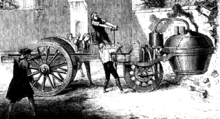- Nicolas-Joseph Cugnot
-
Nicolas-Joseph Cugnot Born 26 February 1725
Void-Vacon, LorraineDied 2 October 1804 Nationality French Work Significant projects fardier à vapeur Nicolas-Joseph Cugnot (26 February 1725 – 2 October 1804) was a French inventor. He is believed to have built the first self-propelled mechanical vehicle. This claim is disputed by some sources, however, which suggest that Ferdinand Verbiest, as a member of a Jesuit mission in China, may have been the first to build a 'car' around 1672.[1][2]
Contents
Background
Cugnot was born in Void-Vacon, Lorraine, (now departement of Meuse), France. He trained as a military engineer. He experimented with working models of steam-engine-powered vehicles for the French Army, intended for transporting cannon, starting in 1765.
The first self-propelled vehicle?
Cugnot was one of the first to employ successfully a device for converting the reciprocating motion of a steam piston into rotary motion by means of a ratchet arrangement. A small version of his three-wheeled fardier à vapeur ("steam dray") ran in 1769. (A fardier was a massively built two-wheeled horse-drawn cart for transporting very heavy equipment such as cannon barrels).
 Cugnot's 1771 fardier à vapeur, as preserved at the Musée des Arts et Métiers, Paris.
Cugnot's 1771 fardier à vapeur, as preserved at the Musée des Arts et Métiers, Paris.
The following year, a full-size version of the fardier à vapeur was built, specified to be able to carry 4 tons and cover 2 lieues (7.8 km or 4.8 miles) in one hour, a performance it never achieved in practice. The vehicle, which weighed about 2.5 tonnes tare, had two wheels at the rear and one in the front where the horses would normally have been; this front wheel supported the steam boiler and driving mechanism. The power unit was articulated to the "trailer" and steered from there by means of a double handle arrangement. One source states that it seated four passengers and moved at a speed of 2.25 miles per hour.[3]
The vehicle was reported to have been very unstable due to poor weight distribution - which would have been a serious disadvantage seeing that it was intended that the fardier should be able to traverse rough terrain and climb steep hills. In 1771, the second vehicle is said to have gone out of control and knocked down part of the Arsenal wall, (the first known 'automobile' accident?); however according to Georges Ageon,[4] the earliest mention of this occurrence dates from 1801 and it does not feature in contemporary accounts. Boiler performance was also particularly poor, even by the standards of the day, with the fire needing to be relit and steam raised again every quarter of an hour or so, considerably reducing overall speed.
After running a small number of trials variously described as being between Paris and Vincennes and at Meudon, the project was abandoned and the French Army's experiment with mechanical vehicles came to an end. Even so in 1772, King Louis XV granted Cugnot a pension of 600 livres a year for his innovative work and the experiment was judged interesting enough for the fardier to be kept at the Arsenal until transferred to the Conservatoire National des Arts et Métiers in 1800, where it can still be seen today.
Later life
With the French Revolution, Cugnot's pension was withdrawn in 1789, and the inventor went into exile in Brussels, where he lived in poverty. Shortly before his death, he was invited back to France by Napoleon Bonaparte and Nicolas-Joseph Cugnot returned to Paris, where he died on 2 October 1804.
See also
References
- ^ "1679-1681 – R P Verbiest's Steam Chariot". History of the Automobile: origin to 1900. Hergé. http://translate.google.com/translate?hl=en&sl=fr&u=http://users.skynet.be/tintinpassion/VOIRSAVOIR/Auto/Pages_auto/Auto_001.html&sa=X&oi=translate. Retrieved 2009-05-08.
- ^ Setright, L. J. K. (2004). Drive On!: A Social History of the Motor Car. Granta Books. ISBN 1-86207-698-7.
- ^ L. A. Manwaring, The Observer's Book of Automobiles (12th ed.) 1966, Library of Congress catalog card # 62-9807. p. 7
- ^ "Le fardier de Cugnot". http://www.ile-de-france.drire.gouv.fr/vehicules/homolo/cnrv/histoire.htm.
- Max J. B. Rauck, Cugnot, 1769-1969: der Urahn unseres Autos fuhr vor 200 Jahren, München: Münchener Zeitungsverlag, 196
- Bruno Jacomy, Annie-Claude Martin: Le Chariot à feu de M. Cugnot, Paris, 1992, Nathan/Musée national des techniques, ISBN 2-09-204538-5.
- Louis Andre: Le Premier accident automobile de l'histoire , in La Revue du Musée des arts et métiers, 1993, Numéro 2, p 44-46
External links
- The fardier exhibit at the Musee National des Arts et Métiers:
- Cugnot on 3wheelers.com
- Link to downloadable video at DB Museum, showing a reconstruction of the fardier in action (B&W)
- Replica at the Tampa Bay Automobile Museum
- Hybrid-Vehicle.org: The Steamers
- Le fardier de Cugnot: page in French about Cugnot and his invention, hosted at an Île-de-France regional government web site and credited to the Société des ingénieurs de l'automobile (Society of Automotive Engineers).
- Biography of Cugnot from 'World of Invention'
Categories:- 1725 births
- 1804 deaths
- People from Meuse
- French inventors
- People of the French Revolution
- French mechanical engineers
- Steam road vehicles
Wikimedia Foundation. 2010.




